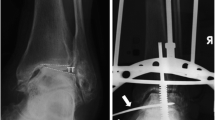Abstract
Background
The success of ankle distraction arthroplasty relies on the separation of the tibiotalar articular surfaces.
Question/Purpose
The purpose of this study was to find the minimum distraction gap needed to ensure that the tibiotalar joint surfaces would not contact each other with full weight-bearing while under distraction.
Methods
Circular external fixators were mounted to nine cadaver ankle specimens. Each specimen was then placed into a custom-designed load chamber. Loads of 0, 350, and 700N were applied to the specimen. Radiographic joint space was measured and joint contact pressure was monitored under each load. The external fixator was then sequentially distracted, and the radiographic joint space was measured under the three different loads. The experiment was stopped when there was no joint contact under 700N of load. The radiographic joint space was measured and the initial (undistracted) radiographic joint space was subtracted from it yielding the distraction gap. The minimum distraction gap (mDG) that would provide total unloading was calculated.
Results
The average mDG was 2.4 mm (range, 1.6 to 4.0 mm) at 700N of load, 4.4 mm (range, 3.7 to 5.8 mm) at 350N of load, and 4.9 mm (range, 3.7 to 7.0 mm) at 0N of load.
Conclusion
These results suggest that if the radiographic joint space of on a standing X-ray of an ankle undergoing distraction arthroplasty shows a minimum of 5.8 mm of DG, then there will be no contact between joint surfaces during full weight-bearing. Therefore, 5 mm of radiographic joint space, as recommended historically, may not be adequate to prevent contact of the articular surfaces during weight-bearing.






Similar content being viewed by others
References
Buckwalter JA, Mankin HJ. Articular cartilage: degeneration and osteoarthritis, repair, regeneration, and transplantation. Instr Course Lect. 1998; 47: 487-504.
Inda D, Blyakher A, O’Malley M, et al. Distraction arthroplasty for the ankle using the Ilizarov frame: techniques in foot & ankle surgery. Tech Foot Ankle Surg. 2003; 2(4): 249-253.
Intema F, Thomas TP, Anderson DD, et al. Subchondral bone remodeling is related to clinical improvement after joint distraction in the treatment of ankle osteoarthritis. Osteoarthr Cartil. 2011; 19: 668-675.
Lajeunesse D. The role of bone in the treatment of osteoarthritis. Osteoarthr Cartil. 2004; 12(Suppl A): S34-S38.
Lamm BM, Gourdine-Shaw M. MRI evaluation of ankle distraction: a preliminary report. Clin Podiatr Med Surg. 2009; 26: 185-91.
Marijnissen ACA, Vincken KL, Viergever MA. Ankle images digital analysis (AIDA): digital measurement of joint space width and subchondral sclerosis on standard radiographs. Osteoarthr Cartil. 2001; 9: 264-272.
Muniz AMS, Nadal J. Application of principal component analysis in vertical ground reaction force to discriminate normal and abnormal gait. Gait Posture. 2009; 29(1): 31-35.
Paley D, Lamm BM, Purohit RM, et al. Distraction arthroplasty of the ankle—how far can you stretch the indications? Foot Ankle Clin. 2008; 13: 471-484.
Tellisi N, Fragomen A, Kleinmann D, et al. Joint preservation of the osteoarthritic ankle using distraction arthroplasty. Foot Ankle Int. 2009; 30(4): 318-325.
Van Roermund PM, Marijnissen AC, Lafeber FP. Joint distraction as an alternative for the treatment of osteoarthritis. Foot and Ankle Clinics of North America. 2002; 7(3): 515-527.
Van Valburg A, van Roermund P, Lammens J, et al. Can Ilizarov joint distraction delay the need for an arthrodesis of the ankle? A preliminary report. J Bone Joint Surg Br. 1995; 77-B(5): 720-725.
Van Valburg AA, van Roermund PM, Marijnissen ACA, et al. Joint distraction in treatment of osteoarthritis: a two-year follow-up of the ankle. Osteoarthr Cartil. 1999; 7(5): 474-479.
Van Valburg AA, Van Roermund PM, Marijnissen AC, et al. Joint distraction in treatment of osteoarthritis (II): effects on cartilage in a canine model. Osteoarthr Cartil. 2000; 8(1): 1-8.
Van Valburg AA, van Roy HL, Lafeber FP, et al. Beneficial effects of intermittent fluid pressure of low physiological magnitude on cartilage and inflammation in osteoarthritis. An in vitro study. J Rheumatol. 1998; 25(3): 515-520.
Disclosures
Conflict of Interest:
Austin Fragomen, MD, is a paid consultant for Smith & Nephew and receives royalties from Small Bone Innovations (outside the work). S. Robert Rozbruch, MD, is a paid consultant for Smith & Nephew and receives royalties from Small Bone Innovations (outside the work). Thomas McCoy and Kathleen Meyers have declared that they have no conflicts of interest.
Human/Animal Rights:
This article does not contain any studies with human or animal subjects performed by the any of the authors.
Informed Consent:
N/A
Required Author Forms
Disclosure forms provided by the authors are available with the online version of this article.
Author information
Authors and Affiliations
Corresponding author
Additional information
This work was performed at the Hospital for Special Surgery, New York, NY.
Rights and permissions
About this article
Cite this article
Fragomen, A.T., McCoy, T.H., Meyers, K.N. et al. Minimum Distraction Gap: How Much Ankle Joint Space Is Enough in Ankle Distraction Arthroplasty?. HSS Jrnl 10, 6–12 (2014). https://doi.org/10.1007/s11420-013-9359-3
Received:
Accepted:
Published:
Issue Date:
DOI: https://doi.org/10.1007/s11420-013-9359-3




